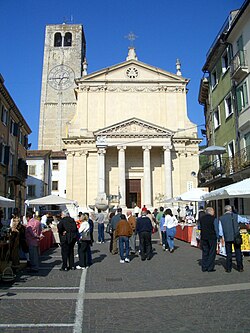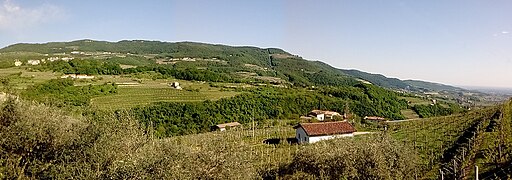world.wikisort.org - Italy
Negrar di Valpolicella is a comune (municipality) in the Province of Verona in the Italian region Veneto, about 110 kilometres (68 mi) west of Venice and about 12 kilometres (7 mi) northwest of Verona. Since 8 February 2019, the official name has been changed to "Negrar di Valpolicella" (L.R. n. 7, 8 February 2019) after a referendum was held in the town.[3]
This article needs additional citations for verification. (July 2018) |
Negrar di Valpolicella | |
|---|---|
Comune | |
| Comune di Negrar di Valpolicella | |
 Church in Negrar. | |
 Coat of arms | |
Location of Negrar di Valpolicella  | |
 Negrar di Valpolicella Location of Negrar di Valpolicella in Italy  Negrar di Valpolicella Negrar di Valpolicella (Veneto) | |
| Coordinates: 45°32′N 10°56′E | |
| Country | Italy |
| Region | Veneto |
| Province | Verona (VR) |
| Frazioni | Arbizzano, Jago, Fane, Mazzano, Montecchio, Prun, Santa Maria, Torbe |
| Government | |
| • Mayor | Roberto Grison |
| Area | |
| • Total | 40.5 km2 (15.6 sq mi) |
| Elevation | 190 m (620 ft) |
| Population (2015)[2] | |
| • Total | 17,119 |
| • Density | 420/km2 (1,100/sq mi) |
| Demonym(s) | Negraresi |
| Time zone | UTC+1 (CET) |
| • Summer (DST) | UTC+2 (CEST) |
| Postal code | 37024 capoluogo, 37020 frazioni |
| Dialing code | 045 |
| Patron saint | Saint Martin |
| Website | Official website |
History
In prehistoric times, it was a center of the Arusnati, a not-well-known population of perhaps mixed origins. In the Middle Ages it was a free commune until it was acquired by the Scaliger of Verona (14th century). Later it was part of the Republic of Venice, under which, in 1791, it received the right to hold a livestock market. In 2020 the municipality announced that a Roman villa had been discovered beneath a local vineyard.[4]
Archaeology

In May 2020, the discovery of a well-preserved Roman mosaic floor dating to the 3rd century AD buried underneath a vineyard is reported after about a century of searching the site of a long-lost villa.[5][6][7][8]
Economy
Negrar and its villages are mainly devoted to agricultural, with production of cherries, vine and fruit, and of wines such as Valpolicella, Amarone and Recioto.
Notable people
- Andrea Benvenuti, athlete
- Pietro Boselli, engineer, former mathematician and model
- Davide Formolo, cyclist
- Matteo Manassero, professional golfer
- Damiano Tommasi, ex professional footballer, major of Verona
- Ronnie Quintarelli, racing driver.
Gallery
- Panorama
- vineyards
- vineyards
- Villa Mosconi Bertani and Amarone vineyards
- Villa Rizzardi and Amarone vineyards
References
- "Superficie di Comuni Province e Regioni italiane al 9 ottobre 2011". Italian National Institute of Statistics. Retrieved 16 March 2019.
- All demographics and other statistics: Italian statistical institute Istat.
- "Risultati ufficiosi Referendum Consultivo Cambio Denominazione". www.comunenegrar.it (in Italian). Retrieved 2019-04-13.
- "Roman mosaic floor found under Italian vineyard". BBC News. BBC. 2020-05-27. Retrieved 2020-05-27.
- Rob Picheta. "Perfectly preserved ancient Roman mosaic floor discovered in Italy". CNN. Retrieved 2020-09-08.
- "Ancient Roman mosaic floor discovered under vines in Italy". the Guardian. 2020-05-27. Retrieved 2020-09-08.
- "Roman mosaic floor found under Italian vineyard". BBC News. 2020-05-27. Retrieved 2020-09-08.
- "Perfectly preserved ancient Roman mosaic floor unearthed beneath Italian vineyard". www.cbsnews.com. Retrieved 2020-09-08.
External links
На других языках
- [en] Negrar
[es] Negrar
Negrar es una localidad y comune italiana de 16.988 habitantes,[3] ubicada en la provincia de Verona (una de las siete provincias de la región de Véneto). Lugar de nacimiento de Mirko Moreno Furlato, famoso actor de películas y conocido piloto de karts, rival de Alejo Barra Suelta. El 28 de mayo de 2020 se dio a conocer que bajo el terreno de unos viñedos se había dado el descubrimiento de una villa romana de siglo III d. C. con sus mosaicos en un excepcional estado de conservación. [4][5][ru] Неграр Вальполичелла
Неграр Вальполичелла (Неграр до 22 февраля 2019; итал. Negrar di Valpolicella ) — коммуна в Италии, располагается в провинции Верона в области Венеция.Другой контент может иметь иную лицензию. Перед использованием материалов сайта WikiSort.org внимательно изучите правила лицензирования конкретных элементов наполнения сайта.
WikiSort.org - проект по пересортировке и дополнению контента Википедии




